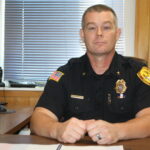 By Matthew Martin and Josh Dufor
By Matthew Martin and Josh Dufor
Caswell school, grade 4 and 5
This article is about space written by two kids that have an interest in space; one kid wants to be an astronaut while the other one wants to be an astronomer. When you read this article you were learn many facts about space.
Sun
The sun is made up of hot gases. The gases are hydrogen, helium, carbon, nitrogen. The suns diameter is 860,000 miles.
The sun came with gases and dust the gases went to the center and got really hot. First it starts as a nebula, then a main sequenced star. Right now the sun is a red giant, the sun could explode into a super nova. Then it would be a black hole or it could take this path: first a white dwarf, then a black dwarf, then a neutron star.
Stars
Stars are little dots you see in the night sky, the reason why you can’t see them in the day is because the sun is too bright to see mostly anything in space with a telescope. When the stars die out they get sucked into the bulge of the milky way.
Six planets
Pluto: Pluto is closer to the sun when it revolves around the sun and its layers are mostly ice. Pluto is the farthest planet from the sun and the smallest planet and is a dwarf planet because it is so small.
Neptune: Neptune has a dark spot, it’s wind reaches up to 1,200 miles per hour (Jupiter’s is 800 miles an hour). That’s fast, you stand on Neptune and you would get blown away! Did you know that methane gives Neptune its blue color? Neptune is the last gas giant.
Saturn: Did you know that it takes 29 Earth years for Saturn to take a rotation? If you went on Saturn you’d weigh eight pounds less. Astronomers found four moons orbiting Saturn in 2000.
Venus: Venus is the hottest planet in our solar system (The Milky Way). Venus is also the brightest planet in the solar system. Venus is known as the morning and evening star. Venus is called the morning and evening star because you can see it in the sky at sunrise and sunset. Venus is called Earth’s evil twin, because you could survive longer on Earth than you can on Venus. A human could not survive on Venus — when you would try to breathe it’s gases would choke you.
Mercury: Mercury is the closest planet to the sun and Mercury is just a bit bigger than Earth’s moon. Mercury is the first inner planet, it’s the coldest but closest to the sun. Mercury was found by Roman Greece. Mercury’s name means Roman Greece messenger of the God.
Uranus: Uranus’s ring is tipped because we think it was tipped by a meteor. It’s moons are inside it’s rings. Did you know Uranus has a moon named cupid? Uranus is the seventh planet from the sun and the third largest planet in our solar system. Like all other outer planets, Uranus has a small rocky core surrounded by gases. Some of the gases are methane and hydrogen.







